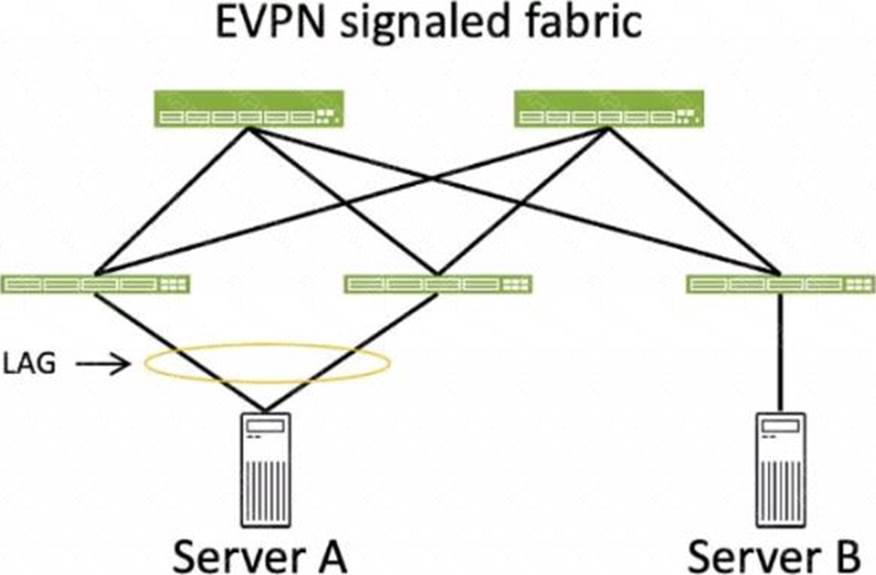Which two statements about ESI values are correct for the server connections to the fabric shown in the exhibit?
Exhibit.

Which two statements about ESI values are correct for the server connections to the fabric shown in the exhibit? (Choose two.)
A. A valid ESI value for Server A is 0x00.00.00.00.00.00.00.00.00.00.
B. A valid ESI value for Server B is 0x00.20.20.20.20.20.20.20.20.20.
C. A valid ESI value for Server A is 0x00.10.10.10.10.10.10.10.10.10.
D. A valid ESI value for Server B is 0x00.00.00.00.00.00.00.00.00.00.
Answer: C D
Explanation:
To answer this question, we need to understand the concept of ESI values in EVPN LAGs. An ESI is a 10-byte value that identifies an Ethernet segment, which is a set of links that connect a multihomed device (such as a server) to one or more PE devices (such as leaf switches) in an EVPN network. The same ESI value must be configured on all the PE devices that connect to the same Ethernet segment. This allows the PE devices to form an EVPN LAG, which supports active-active or active-standby multihoming for the device. The ESI value can be manually configured (type 0) or automatically derived from LACP (type 1) or other methods. In the exhibit, Server A is connected to two leaf switches (QFX 5210) using a LAG with LACP enabled. Server B is connected to three leaf switches (QFX 5120) using a LAG with LACP enabled.
Based on this information, the following statements are correct about ESI values for the server connections to the fabric:
– C. A valid ESI value for Server A is 0x00.10.10.10.10.10.10.10.10.10. This is true because this ESI value can be automatically derived from the LACP configuration on the QFX 5210 devices. The LACP system ID is usually based on the MAC address of the device, and the LACP administrative key is a 2-byte value that identifies the LAG. For example, if the MAC address of the QFX 5210 device is 00:10:10:10:10:10 and the LAG ID is 10, then the LACP system ID is 00:10:10:10:10:10 and the LACP administrative key is 00:0A. The ESI value is then derived by concatenating the LACP system ID and the LACP administrative key, resulting in 00:10:10:10:10:10:00:0A. This ESI value can be represented in hexadecimal notation as 0x00.10.10.10.10.10.00.0A, or padded with zeros as 0x00.10.10.10.10.10.00.0A.00.00. This ESI value must be configured on both QFX 5210 devices that connect to Server A.
– D. A valid ESI value for Server B is 0x00.00.00.00.00.00.00.00.00.00. This is true because this ESI value is a reserved value that indicates a single-homed device. Server B is connected to three leaf switches (QFX 5120) using a LAG, but it is not multihomed to any of them. This means that Server B does not need an ESI value to form an EVPN LAG with any of the leaf switches. Instead, Server B can use the reserved ESI value of 0x00.00.00.00.00.00.00.00.00.00, which indicates that it is a single-homed device and does not participate in any EVPN LAG. This ESI value must be configured on all three QFX 5120 devices that connect to Server B. Thefollowing statements are incorrect about ESI values for the server connections to the fabric:
– A. A valid ESI value for Server A is 0x00.00.00.00.00.00.00.00.00.00. This is false because this ESI value is a reserved value that indicates a single-homed device. Server A is connected to two leaf switches (QFX 5210) using a LAG with LACP enabled, which means that it is multihomed to both of them. This means that Server A needs an ESI value to form an EVPN LAG with the leaf switches. The ESI value must be unique and non-zero for each Ethernet segment, so the reserved ESI value of 0x00.00.00.00.00.00.00.00.00.00 is not valid for Server A.
– B. A valid ESI value for Server B is 0x00.20.20.20.20.20.20.20.20.20. This is false because this ESI value is not derived from the LACP configuration on the QFX 5120 devices. Server B is connected to three leaf switches (QFX 5120) using a LAG with LACP enabled, but it is not multihomed to any of them. This means that Server B does not need an ESI value to form an EVPN LAG with any of the leaf switches. Instead, Server B can use the reserved ESI value of 0x00.00.00.00.00.00.00.00.00.00, which indicates that it is a single-homed device and does not participate in any EVPN LAG. The ESI value of 0x00.20.20.20.20.20.20.20.20.20 is not valid for Server B, and it may cause conflicts with other Ethernet segments that use the same ESI value.
References:
– Ethernet Segment Identifiers, ESI Types, and LACP in EVPN LAGs
– Understanding Automatically Generated ESIs in EVPN Networks
– Ethernet Segment in EVPN: All You Need to Know
Latest JN0-480 Dumps Valid Version with 65 Q&As
Latest And Valid Q&A | Instant Download | Once Fail, Full Refund

